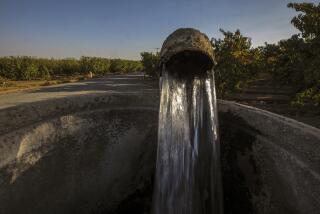Short-Lived Water Truce
- Share via
On June 9, Gov. Gray Davis and Interior Secretary Bruce Babbitt all but declared peace in our time for the world of California water resources. Then it all started falling apart. The water wars are back, with potentially dire consequences for the state’s ability to meet human and environmental needs over the next 20 years.
This is not just California’s old north-south conflict. That was simple. Now, farmers are fighting the federal government, environmentalists and one another. Urban water agencies are scraping for every bucket of water they can find. Arizona, Nevada, Colorado and other states are ready to pounce if California doesn’t cut back on its take from the Colorado River.
California officials forecast a statewide shortage of 2.4 million acre-feet in an average year by 2020, and more than 6 million acre-feet if there’s a drought. For comparison, Los Angeles homes and businesses use an average of 630,000 acre-feet a year, and the state is about due for drought. Since 1912, California has suffered one drought every nine years on average. The last dry period ended eight years ago. The supply gap can be closed, but that would require removal of legal and other barriers.
The Davis-Babbitt meeting produced general agreement on the state-federal cooperation known as the Cal-Fed process. The aim was to resolve disputes over southbound water exports from the Sacramento-San Joaquin Delta. Five years of negotiation had produced a compromise plan expected to cost $8.6 billion over the next decade. The new framework would begin to fix many of the state’s major water problems, even sending better-quality water to Southern California. But the deal is creaky at best.
Three lawsuits have been filed challenging Cal-Fed: by the Farm Bureau, arguing that agriculture gets shorted, by rural counties in Northern California that fear the south will take more of their water and by the Orange County water district, wanting more water. State officials don’t think these suits will destroy Cal-Fed, but it will take time to measure the damage.
Another court ruling has jeopardized the landmark 1994 Monterey Agreement, which revised water contracts between the state Water Project and its customers, partly to pave the way for water transfers from farms to urban areas. The state appeals court said the agreement violated land-use goals by holding out the false expectation that the project would be able to deliver about twice as much water as it ever could--”paper water,” the court called it.
The most alarming development came this summer when the Westlands Water District, a consortium of large farms on the west side of the San Joaquin Valley, filed a claim for 30% of the San Joaquin River water that smaller east valley farmers have used for half a century. Settling this claim may take four years or longer. A Westlands victory could cast doubt on the validity of water rights throughout the state.
There’s not a crisis right now. But it is a crisis in the making. Without strong leadership focused on reconciliation, California’s progress toward long-term water sufficiency will stall. The next drought, and the one after that, will not wait while water users squabble.
More to Read
Sign up for Essential California
The most important California stories and recommendations in your inbox every morning.
You may occasionally receive promotional content from the Los Angeles Times.













